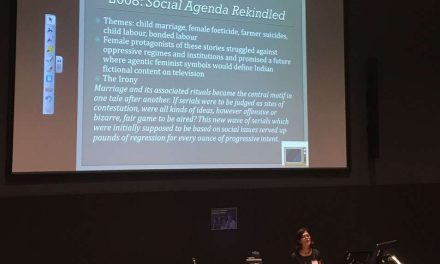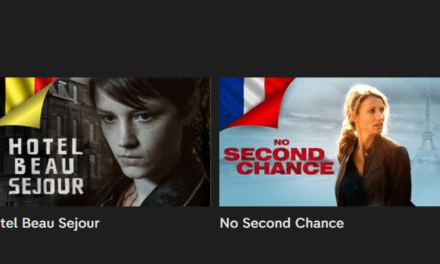Cathy Johnson and Karen Boyle’s recent blog posts on Working Ourselves and Others to Death have generated an animated and, in my eyes, helpful debate that has also allowed me to take stock on where some of my colleagues and myself are in terms of our working patterns. Some of these discussions have already born fruit – even if it was just in small steps by reminding PhD students to take time out, insisting on taking lieu days for open days worked at weekends, etc. and reflecting on how I can renegotiate some of my workload for next year. However, the more profound awareness that the issue has generated for me is of the problem of my television consumption.
Let me put it bluntly: when do you actually have time to watch television?
My particular circumstances are probably heightened by the fact that I have a relatively young family which is coupled with a wish to spend relative quality time in the evenings without television while we have dinner and get ready for bed. After that, at around 7.30pm, I do usually sit down in front of the television, but then my problems begin: there’s usually more work to be done – from emails, to giving feedback to marking – so that I usually put the volume down so much that I can hardly hear the TV. With my eyes largely fixed on the laptop screen – a typical second screen for my generation – the varying sound levels (see Lury 2005) barely have a chance to return my wandering eye to the supposedly primary screen.
And there is more: on the days when I do get to watch television with a sense of intent – and with the second screen only as the occasional distraction – I find I have a lot of catching up to do. The list of recommendations is long, and due to my specific recent research also only largely available on demand or on DVD. The effects are two-fold: on the one hand, I find myself, supposedly in line with a large number of the rest of the population, binge-watching, and on the other hand, the programmes I do watch are inevitably divorced from their televisual flow for which they were – usually at least – planned.
All of this, of course, creates a sense of binary engagement: concentrated viewing is reserved for (primarily American) TV drama, whilst live television only receives a cursory glance. Some commentators would suggest that this is fairly typical based on their own experiences. However, the concern for me is that this is actually fairly atypical for the whole of the population.
The 2014 Ofcom Market Report indicated that live television remains the most-consumed form of media in the UK with nearly 3 hours per day (2 hours 58 minutes). Often, this involves some forms of multi-tasking including watching television while speaking to someone on the phone which is the most popular form of media multi-tasking. Interestingly, 82% of adults in the UK still watch live television every day, whilst 94% watch live television at least once every week. Most of their television consumption peaks at 9pm with 80% of adults watching live television at that time. In total, adults still spend 37% – so more than a third of all their media activity watching television, with adults older than 65 years spending nearly half their communication time (49%) on watching television.
Of course, we see significant changes. As Ofcom points out in their key facts summary:
However, young people spend as much time on text communications as watching TV or films on a TV set. Among all adults, 37% of total time spent on media and communications activities is attributed to watching TV or films on a television set. However, only a quarter (24%) of the media and communications activity of an average 16-24 year-old is spent doing this, compared to half (49%) for those aged 65 and older. The pattern switches for text communications; for 16-24 year olds, 23% of their media time is spent engaged in this form of activity (such as texting or communicating via social networks) compared to 7% for those aged 65+.
What is interesting about this particular paragraph is that it feeds straight into assumptions about young people deserting television and instead moving to social media. However, the figures here suggest near parity between these two activities, and indeed a still minor preference for television. Similarly in discussing the decline in live television consumption in the young (16-24) age group, Ofcom uses language that suggests a significant shift away from live television. This is supported by a comparison of that age group to older audiences: while ‘adults’ spend 69% of their time watching live television, for the 16-24-year-olds, it’s only 50%.
So, 50% of all moving image consumption of teenagers is still live, while 13% of their time is spent watching streamed or downloaded content, and 8% of their time is spent on short online content (read Youtube, Vine, clips on Facebook, etc.).
Let me say it again: 50% of teenagers’ moving image consumption is focused on the consumption of live television.
Considering what we know about teenagers’ television consumption in the past (i.e. that they notoriously disengage with television more generally and have proven to be the most difficult to capture for broadcasters) and considering the many accounts of the end of live television consumption by our young audiences, including in academic circles, this should come as a bit of a surprise. As the representatives of Ofcom at the 2015 MeCCSA conference indicated, live television remains very resilient. But that highlights also that most television, including the one chosen by the young generation, is still consumed within the context of its traditional flow, where the place in the schedules gives meaning to a programme, and additional texts placed around and within programmes (including trailers, adverts and idents) create additional associations that add to the textual richness of the programme text proper.

I notice this loss of textual richness in particular when I catch up on some of my favourite US network programmes, including CSI. Without the adverts in the breaks, the programme just doesn’t quite feel the same. Much of this is to do with the fact that CSI’s pleasures partially rely on its aesthetic appeal that is connected to the expensive, high-gloss production values producer Jerry Bruckheimer is famous for. But these production values in CSI are concentrated in moments of spectacular visual pleasure – such as the interior body shots, but also complex montage sequences accompanied by European independent music (see Lury 2007). These moments are surprisingly similar to the production values of adverts which, John Ellis has pointed out, have much more money poured into them per minute than television programmes, even expensive drama productions. Thus, in the case of CSI, the adverts (and idents, which in the case of Channel 5 have been similarly stunning) actually extend and accentuate these pleasures.
But my concern about taking the programmes out of their televisual context is that they take the programmes out of the television text more generally. When we watch things on demand or on DVD or downloaded we see a different text. That might include additional snippets of scenes which are no longer edited for UK broadcast consumption, but it also includes a context of advertising and other interstitials (Ellis) and the explicit branding of programmes with channel logos and idents (Johnson 2012) and connecting them to other programmes via trailers and teasers. The latter are crucial at guiding our attention to other texts which we might want to see and thus arrest our attention much more independently than through the recommendation system of friends and colleagues that currently guide my television consumption. The latter think they know what I like – I am an academic and I like watching television, so surely I must like the quality TV dramas. But my interests are much more diverse and complex: I like a lot of television, and actually I also want to just be able to watch general television. Spending that much time watching ‘quality TV’ on demand skews my experience of television as a fundamentally diverse and varied medium. My fascination with lifestyle programmes and documentaries – which, for a while at least, were pretty much all I watched – has suddenly fallen by the wayside. My addiction to Masterchef has become an unrequited longing for the time when you could just have the television on and watch. But the focus on streamed binge watching actually has meant that the number of programmes that I do get to watch has really shrunk as most of the ones on my ‘to watch’ list are American serials of which you have to watch at least 5 seasons in order ‘to get’ why they are so good. And judging from the proliferation of publications on ‘quality TV’ versus the relative and continued dearth of articles on other genres, I am not the only one faced with this paradox.
To be frank: I – and I think you – just don’t have the time. Television viewing in this context has become a chore, and a chore that further disconnects me from the television consumption of the average population. And this, to me, is a problem. If the scholars of the 1980s had to make a case for the need to investigate television as a whole because it forms such an important part of our daily media consumption, then today we should defend the need for our consumption of a variety of programmes within their textual construct that is the broadcast text. But this means making time for television, and demanding the right to make time for television. In other words, continuing to work days of 11 hours a day is not just unrealistic and unhealthy for us, but it’s actually fundamentally detrimental to the specifics of our jobs.
Elke Weissmann is Reader in Film and Television at Edge Hill University. She is currently considering changing this to Reader in Television and Film, however. Her books include Transnational Television Drama (Palgrave) and the edited collection Renewing Feminisms (I.B.Tauris) with Helen Thornham. She is vice-chair of the ECREA TV Studies Section and sits on the board of editors for Critical Studies in Television. She migrated to the UK in 2002 after realising that German television was as bad as she remembered.





